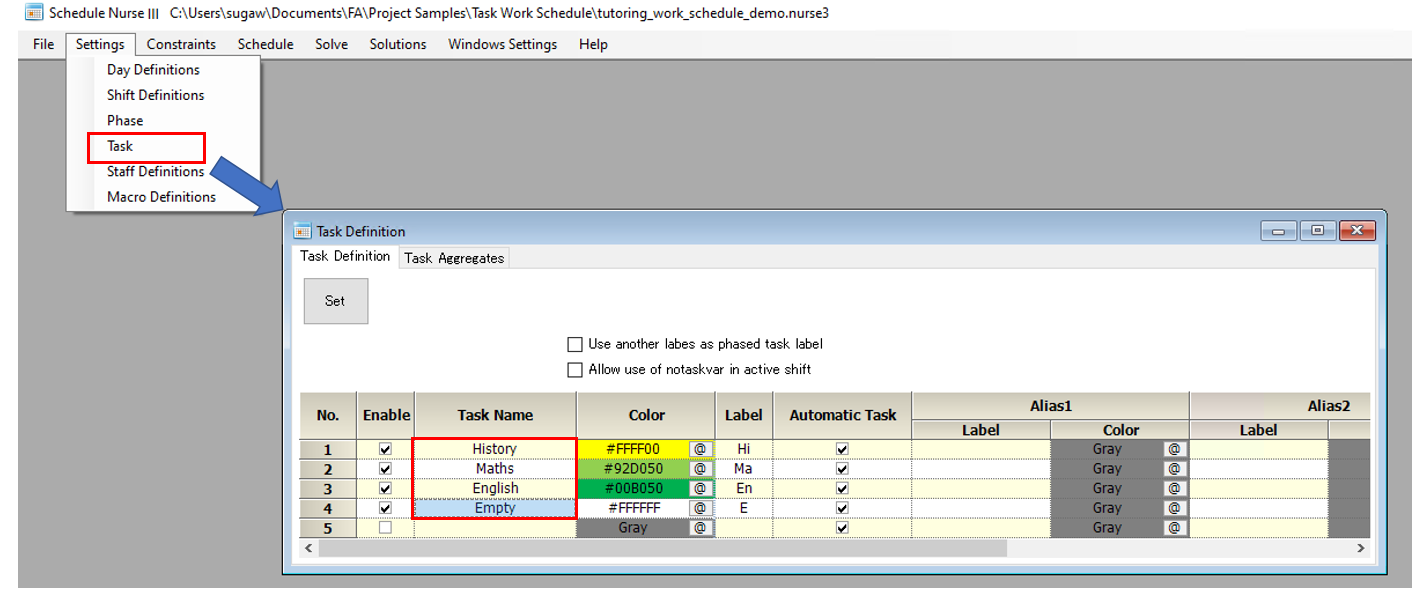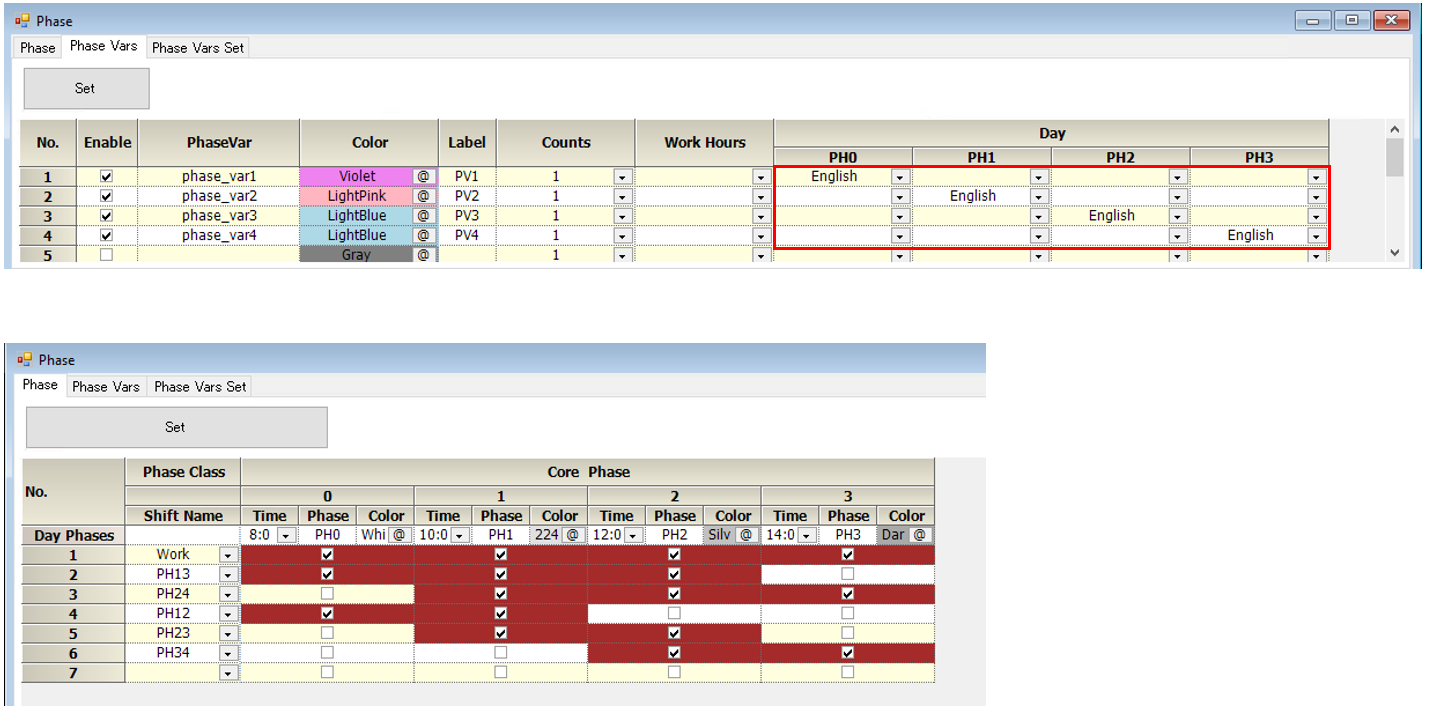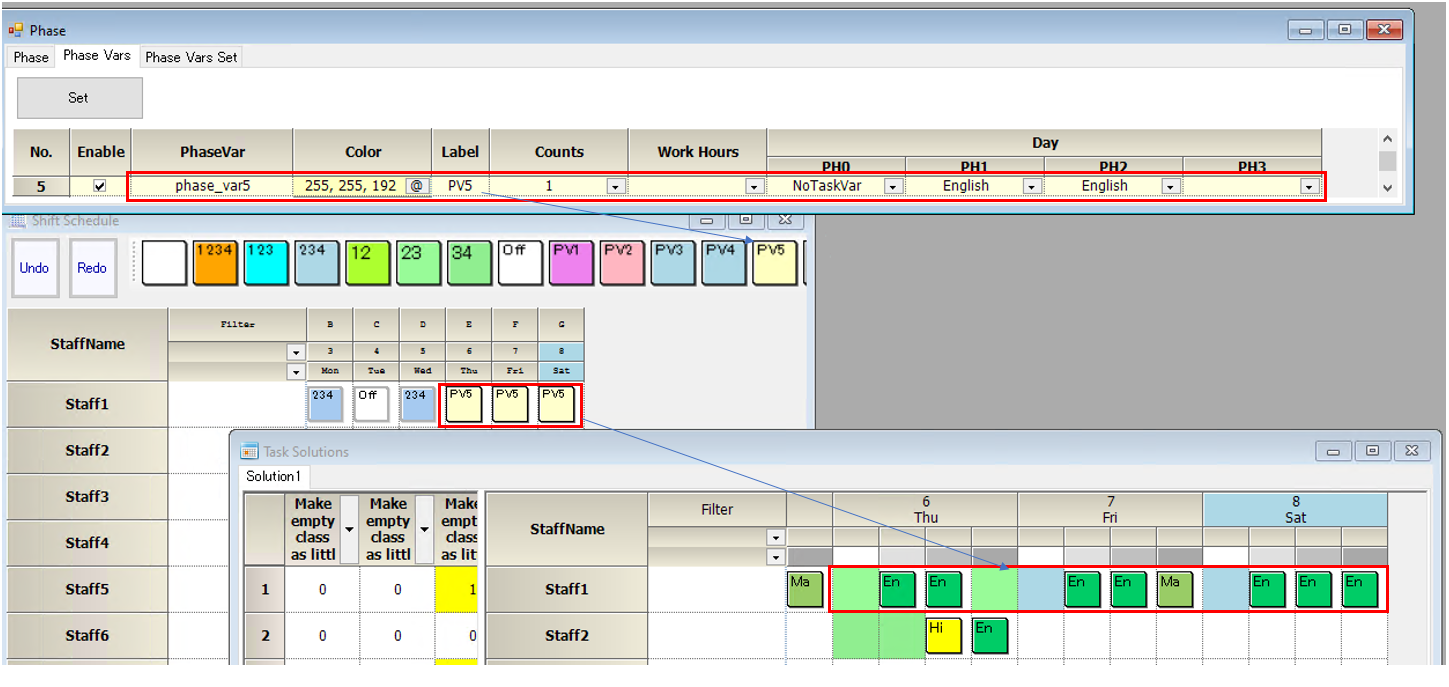Shift work schedules do not require this, but task work schedules require understanding the concepts of task and phase.
Concept of Tasks
Shift refers to the horizontal flow of time, such as Day Shift, Night shift, Early-Night shift, etc.

Shift refers to the horizontal flow of time, such as day shift, night shift, semi-night shift, etc.
In contrast, a task refers to the work , e.g., medical, surgical, emergency, and so on, specifically within the time of the shift.
Let us focus on a single support staff member.
She may work in internal medicine, surgery, or emergency during the hours of the day shift. Each one of these jobs should have a period dedicated to it.

Phase concept
We will call each work period a phase; we define the total number of phases in a day as the number of phases.

Shift Review
There is one active shift per day.
Day shift, Night, and Early Night shift.., there are many different types of shifts, but the number of shifts allowed per staff member per day is one, never more than two, and never zero.
It is always one shift. In other words, one shift is always active, and all other shifts are inactive.
Therefore, it is necessary to describe the “Off” shift.
If it is not a Day shift, Night shift, Early Night shift…, the “Off” shift will be active. In other words, we need to define the “Off” state to satisfy the rule.
This property is common regardless of shift type or task type.
Phase Definition
Connects a shift to a phase. If even one phase is defined in this phase definition, it becomes a task work schedule. Below is an example of a cram school work schedule.
<br
There are up to 4 periods in a day, making it 4 phases.
For example, a shift called “Work” would be for all four periods; a shift called PH13 would be a continuous phase from period 1 to period 3.

■Each phase must have a name.
Each phase must have a time specification. The time specification does not have to match the actual situation, it is just for convenience, but it must be defined to increase.
The total time from the start to the end of the time specification must be less than 24 hours, although crossing over to the next day is OK.
■Each phase must contain at least one shift.
■Phases do not have to be defined consecutively when viewed in a single shift. It is acceptable to straddle them.
■The phase with a checkmark is called the active phase.
Task Definition

■One task is always selected during the active phase. The selected task is called the active task.
A task in the inactive phase will never become active. The number of active tasks during the inactive phase is 0.
■Note that only one task must be selected during the active phase. For example, let’s assume that you have only defined History,Maths,Englishth, and have not defined an “Empty” task.
If there is a possible situation where any of the task can be assigned, this would be a hard error with no solution.
Remember the principle of “One active shift throughout the day and one active task during the active phase (Not two, not zero, but one.)”.
Task Alias Label Option
Check “Use alias labels for each phase” and prepare labels for the number of phases.

Task set
The “operator” can be “or” (OR). The “not” (NOT) can only be used for the particular task “NoTaskVar”,

Phase Objects
A phase object connects a specific phase to a particular task. There are two types of phase objects: phase variable and phase variable set.
Phase objects can be handled in most cases in the same way as shifts.
Phase Variables
Below is an example of a phase variable definition.
Assume phases are now defined from period 1 (ph0) to period 4 (ph3).
For example, the “phase_var1” below can be viewed as the task for ph0, the shift for which English is defined. ph2 (ph0) through ph4 (ph3) are blanks since nothing is defined in them.
The blank section can be anything, but only the first period needs to be in English.

Let’s go back to the phase definition again. We defined it as above.
The shift for which the first period is defined
■Work
■PH13
■PH12
■PH12
only. In other words, “phase_var1” becomes active (selected or 1 of 0/1) only when it is one of the above shifts and the 1st period task is in English.
Similarly, “phase_var2,” “phase_var3,” and “phase_var4” will each limit the possible shifts that may be selected, and the task for each period will be limited to English.
Phase variable set
The phase variable set is the OR (or) of the phase variables.

The phase variable set “POA1” above becomes active (selected or 1 out of 0/1), which means that English will be included in any one of the periods 1 (ph0) through 4 (ph3). In other words, it indicates that at least one English class will be that day.
Phase variable or phase variable set can be referenced as a shift in the shift schedule input or in each constraint.

For example, the above line constraint would say there should be “at least one day with at least one English class.”
Phase variable combines tasks between phases with AND.
The following example enumerates all patterns with two English frames. The constraints list all ways with more than 2 English frames because English may be in the blank section. For example, E21 requires that the first and second periods be in English.

NoTaskVar indicates the unselected status in a special task
NoTaskVar is a special task with a reserved name that becomes active when all other tasks are inactive.

In other words, the NoTaskVar will be active during the 3rd period of the PH13 shift, the 1st period of the PH24 shift, the 3rd and 4th periods of the PH12 shift, etc.

Using this, for example, the following “phase_var5” represents the PH23 or PH24 shift, which is the 2nd period English and 3rd period English. Note that without the NoTaskVar, the shifts cannot be limited.

NOT operation for task sets is possible only with NoTaskVar
In factory processes, a large number of tasks may appear.
In such cases, if you take the NOT of NoTaskVar, you can always manifest “operations” without needing maintenance, even if various tasks increase or decrease.

